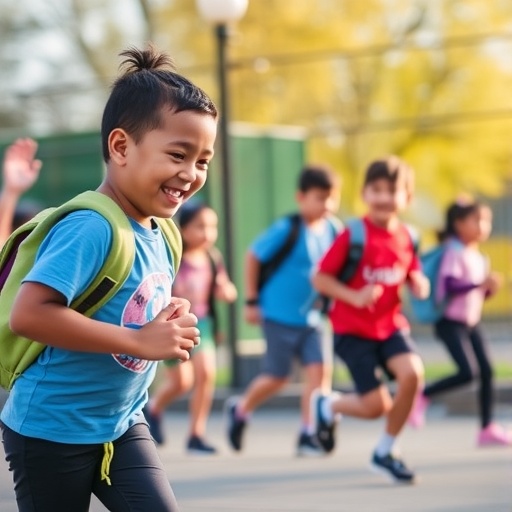A groundbreaking longitudinal study from the University of Georgia’s College of Public Health reveals compelling evidence linking students’ perceptions of their school environment to their levels of physical activity. This research delves deep into the psychosocial factors shaping adolescent behavior, unveiling how a supportive, safe, and inclusive school climate can serve as a catalyst for increased physical engagement among youth. The implications extend far beyond physical fitness, indicating profound effects on mental health and academic achievement. Such findings underscore the critical role schools play in molding not only intellectual growth but also holistic well-being.
The comprehensive analysis draws upon an extensive dataset accumulated over five years from the Georgia Student Health Survey, encompassing responses from more than 685,000 middle and high school students aged between 11 and 17. This vast data trove enables a nuanced longitudinal exploration of how perceptions of school climate intersect with physical activity patterns during pivotal adolescent developmental stages. The multifaceted nature of ‘school climate’ considered in the study comprises dimensions such as connectedness to school, social support from peers and adults, cultural acceptance, perceived safety, and experiences of peer victimization.
Central to the study’s revelations is the strong positive correlation between students who perceive their schools as supportive and inclusive spaces and their propensity to engage in physical activity regularly. Students reporting a secure and welcoming school environment demonstrated increased likelihood of maintaining physical activity at least four to five days per week as they matured, contrasting starkly with those feeling unsafe or neglected, whose activity levels dwindled. This highlights the critical biopsychosocial interplay, where an adolescent’s environmental context directly shapes their health-related behaviors.
The study elegantly elucidates that fostering a positive school climate is not a mere adjunct to academic priorities but a determinant of physical health outcomes. Supporting this, senior author and associate professor Janani Rajbhandari highlights the intricate nexus between physical well-being, mental health, and academic success. Engaged and active students exhibit improved cognitive performance, emotional resilience, and social functioning, with school climate acting as a foundational scaffold upon which these outcomes coalesce.
Yet, the data also spotlight a troubling global trend resonating within Georgia’s student population: the pronounced decline in physical activity as children transition from middle to high school. Peak activity tends to occur at the culmination of middle school years before tapering sharply throughout high school, a pattern particularly acute among female students. The research quantifies this gender disparity, with girls reported to be 17% less active than boys in high school, a discrepancy reflecting complex socio-cultural dynamics and possibly compounded by curricular policies.
Indeed, the state’s minimal mandatory physical education requirement—one credit hour that can be fulfilled through online courses—emerges as a critical contextual factor contributing to this decline in adolescent activity levels. Without structured opportunities for movement integrated into daily school life, engagement depends heavily on extracurricular participation, such as team sports. This reliance disproportionately disadvantages those not involved in such activities, especially girls, further exacerbating health inequities.
Prior investigations corroborate that the school climate’s influence on physical activity differs by gender, underscoring the necessity of tailored interventions sensitive to these distinctions. The present study reinforces this by spotlighting the pivotal adolescence phase as a strategic window to instill lifelong habits. With adolescent behaviors often persisting into adulthood, promoting positive environmental influences during these years becomes paramount for long-term public health trajectories.
Beyond the interpersonal and cultural aspects, the study also draws attention to physical environment factors within schools themselves—such as availability and accessibility of recreational spaces—which modulate students’ likelihood to engage in physical activity. This spatial dimension adds a layer of complexity to efforts aimed at optimizing school settings, necessitating coordinated policies that enhance physical infrastructures alongside social climates.
Mental health repercussions ripple through the findings, as physical activity is well-documented to buffer against psychological distress, enhance mood regulation, and foster resilience. The synergy between a supportive school ambiance and increased exercise not only mitigates anxiety and depression risks but also propels academic motivation and concentration. This holistic perspective challenges educational institutions to transcend narrow academic metrics and adopt comprehensive wellness frameworks.
The study’s methodological rigor—leveraging an enormous longitudinal dataset—affords robust causal inferences rarely attainable in adolescent health research. By characterizing how shifts in school climate perceptions temporally predict changes in physical activity behaviors, this investigation marks a significant advance, charting actionable scientific pathways. It advocates for holistic school-based interventions incorporating programmatic enhancements, adult engagement strategies, peer support systems, and inclusive cultural practices to foster environments conducive to physical and psychological flourishing.
In conclusion, the University of Georgia study offers a clarion call for policymakers, educators, and public health practitioners to recognize the symbiotic relationship between school climate and adolescent health behaviors. Investing in nurturing school environments is not merely an educational imperative but a vital public health strategy with cascading benefits for physical activity engagement, mental well-being, and academic excellence. The future of child and adolescent health may indeed hinge on transforming schools into arenas where safety, connection, and support are paramount, catalyzing lifelong healthy behaviors.
Subject of Research: The relationship between perceived school climate and physical activity levels among male and female middle to high school students.
Article Title: Physical activity level among male and female middle to high school students and impact of perceived school climate: a longitudinal analysis
News Publication Date: 17-Jul-2025
Web References:
- https://www.frontiersin.org/journals/public-health/articles/10.3389/fpubh.2025.1582693/full
- https://publichealth.uga.edu/
- https://news.uga.edu/healthy-childhood-habits-could-shape-adulthood/
References: The study as published in Frontiers in Public Health, co-authored by Biplav Tiwari, Janani Rajbhandari, Jacob Matta, Linlin Da, Kiran Thapa, Ye Shen, Justin Ingels, and Michael Thomsen.
Keywords: Human health; Students; Educational programs




